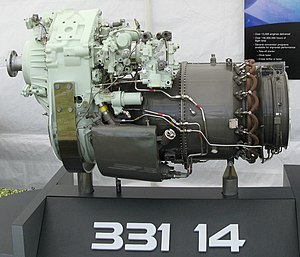Honeywell TPE331
A major contributor to this article appears to have a close connection with its subject. (June 2018) |
| TPE331 / T76 | |
|---|---|

| |
| TPE331-14 | |
| Type | Turboprop |
| National origin | United States |
| Manufacturer | Garrett AiResearch Honeywell Aerospace |
| First run | 1960 |
| Major applications | Fairchild Swearingen Metroliner Mitsubishi MU-2 Rockwell Turbo Commander |
| Number built | 13,500+[1] |
The Honeywell TPE331 (military designation: T76) is a turboprop engine. It was originally designed in the 1950s by Garrett AiResearch, and produced since 1999 by Honeywell Aerospace. The engines power output ranges from 575 to 1,650 shaft horsepower (429 to 1,230 kW).[2][3][4]
Design and development
Garrett AiResearch designed the TPE331 from scratch in 1959 for the military.[5] “Designed as a 575-horsepower engine it was not a scaled-down version of a larger engine, as competitors were offering.”[6] The TPE331 originated in 1961 as a gas turbine (the "331") to power helicopters.[6] It first went into production in 1963.[7] More than 700 had been shipped by the end of 1973.[6] It was designed to be both a turboshaft (TSE331)[8] and a turboprop (TPE331), but the turboshaft version never went into production. The first engine was produced in 1963, installed on the Aero Commander in 1964 and put into production on the Aero Commander Turbo Commander in June 1965.[citation needed]
Performance
The 715 shp TPE331-6 used in the Beech King Air B100 have a 400-hr. fuel nozzle cleaning interval, 1,800-hr. hot section inspection interval and a 5,400-hr. time between overhaul; approval is possible for 3,000-hr. HSIs and 6,000-hr. overhauls and engine reserves are cheaper than for the PT6A.[9]
Applications
- Aero/Rockwell Turbo Commander 680/690/840/980/1000
- Antonov An-2
- Antonov An-38
- Ayres Thrush
- BAe Jetstream 31/32
- British Aerospace Jetstream 41
- Beech B100 King Air
- CASA C-212 Aviocar
- Cessna 441 Conquest II
- Comp Air 9
- Conroy Stolifter
- Dornier 228
- Fairchild Swearingen Metroliner
- General Atomics MQ-9 Reaper
- Grob G 520
- HAL HTT-40
- Kestrel K-350
- Mitsubishi MU-2
- North American Rockwell OV-10 Bronco
- Pilatus/Fairchild PC-6C Turbo-Porter
- Piper Cheyenne 400
- Short SC.7 Skyvan
- Short Tucano
- Swearingen Merlin
Fitted with TPE-331s as a replacement for their original engines
Specifications

General characteristics
- Type: Single-shaft turboprop with integral gearbox
- Length: 46 inches (1,200 mm) (TPE331-43A),[7] 42.82 in (1,088 mm) (TPE331-10)[10]
- Diameter: 21 inches (530 mm) (TPE331-43A)[7]
- Dry weight: 336 lb (152 kg) (TPE331-43A),[7] 385 lb (175 kg) (TPE331-10)[10]
Components
- Compressor: Two-stage centrifugal
- Combustors: Reverse annular
- Turbine: Three-stage axial
Performance
- Maximum power output: 575 hp (429 kW) (TPE331-43A),[7] 940 hp (700 kW) (TPE331-10)[10]
- Overall pressure ratio: 10.55:1 (TPE331-10)[10]
- Specific fuel consumption: 0.534 lb/(hp⋅h) (325 g/kWh) (TPE331-10)[10]
- Power-to-weight ratio: 1.71 hp/lb (2.81 kW/kg) (TPE331-43A),[7] 2.44 hp/lb (4.01 kW/kg) (TPE331-10)[10]
See also
Comparable engines
Related lists
References
- ^ Brecken, Steve (July 2016). "Honeywell Continues to Hone Turboprop Engine for 50th Anniversary" (Press release). Phoenix, Arizona: Honeywell Aerospace. Archived from the original on 2019-07-04.
- ^ "TPE331 Spec Chart". Honeywell Aerospace. Archived from the original (PDF) on 2014-09-03. Retrieved 2014-08-29.
- ^ "TPE". Products & Services. Honeywell Aerospace. Archived from the original on 2010-09-08.
- ^ "TPE331-14 Turboprop Engine" (PDF). Honeywell Aerospace. 2006-07-10. Archived from the original (PDF) on 2014-09-03. Retrieved 2014-08-29.
- ^ "TPE331 Engines Offers Super Performance on Dornier 228 Aircraft" (Press release). Phoenix, Arizona: Honeywell Aerospace. 2017-04-11.
- ^ a b c Schoneberger, William A.; Scholl, Robert R. H. (1985). Out of Thin Air: Garrett's First 50 Years. Garrett Corporation. pp. 153, 174–175, 203. ISBN 9780961702908.
- ^ a b c d e f "Garrett TPE331". Collection. Canadian Museum of Flight. Archived from the original on 2019-07-04.
- ^ Wilkinson, Paul H. (1964). Aircraft engines of the World 1964/65 (20th ed.). London: Sir Isaac Pitman & Sons Ltd. p. 43.
- ^ George, Fred (2017-01-30). "Used Aircraft Report: Beech King Air B100". Business & Commercial Aviation. Aviation Week Network.
- ^ a b c d e f "TPE331-10 Turboprop Engine" (PDF). Honeywell Aerospace. April 2006. Archived from the original (PDF) on 2012-07-19.
External links
- TPE 331 Cost Protection Programs
- TPE 331 Engine Conversions
- Power and fuel flow versus altitude and speed, for version 10. (Archive)
| This aircraft engine article is missing some (or all) of its specifications. If you have a source, you can help Wikipedia by adding them. |
